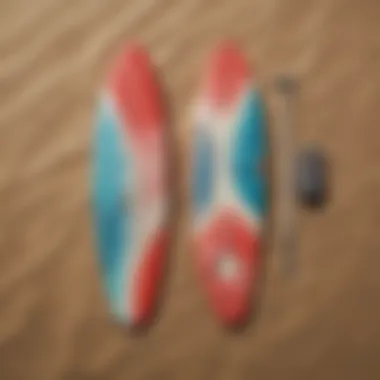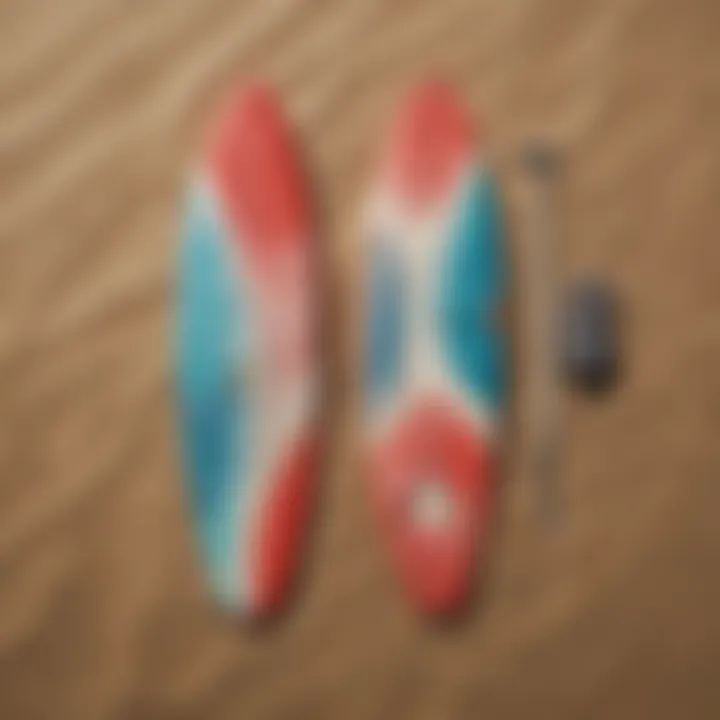The Essential Guide to Boardshorts for Surfing Enthusiasts


Intro
Surfing is not just a sport; it’s a lifestyle that intertwines with elements of adventure, freedom, and connection to the ocean. One essential piece of gear that every surfer, from the rookie catching their first wave to the seasoned wave-rider, needs to consider is boardshorts.
Boardshorts aren’t simply about looking good on the beach; the right pair can dramatically affect comfort, performance, and even safety while riding the waves. In an age where sustainability is more than a buzzword, selecting environmentally-friendly boardshorts is the way forward, making choices that reflect not just style but also a commitment to preserving our oceans.
This guide aims to break down the nuances of boardshorts: what materials are best, how designs suit various surfing styles, how to pick the right size, and understanding the impact of production ethics on your choices. Whether you want to breeze through the surf or tackle more challenging waves, there’s something here for everyone.
Gear Recommendations
Selecting the proper gear for surfing is crucial, especially when it comes to boardshorts. Below, we’ll explore recommendations tailored to different skill levels, providing insights that lead to better performance on the water.
Essential Gear for Beginners
For those just starting their surfing journey, opting for boardshorts that offer comfort without breaking the bank is key. Here are a few considerations:
- Material: Look for boardshorts made from lightweight polyester or nylon. They dry quickly and provide protection against chafing.
- Length: Mid-length boardshorts are often a safe bet, as they provide a good balance between coverage and mobility, allowing for ease of movement while paddling.
- Features: Consider stretchable waistbands, pockets, and quick-drying technologies. These features enhance comfort and convenience while out in the water.
Recommended brands for beginners include Billabong and Hurley, both of which offer economical yet stylish options.
Advanced Equipment for Professionals
For seasoned surfers ready to elevate their game, the choice in boardshorts becomes more intricate:
- Materials: Advanced surfers may prefer boardshorts made from advanced blends like spandex or elastane for flexibility, providing a snug fit that allows for maximum freedom of movement.
- Design: Look for designs with water-resistant coatings and anti-chafing features. These not only improve durability but also enhance performance, giving you confidence to push the limits.
- Fit and Cut: Tailored fits that contour closely to the body without constricting movement are ideal for those who perform high-intensity maneuvers.
Brands like Rip Curl and Quiksilver are distinguished for their premium quality, often incorporating the latest technology in surfwear.
Techniques and Tips
As you venture into the world of surfing, understanding not just your gear, but how to improve skills is essential. Here are some techniques and tips to get ahead:
Skill Improvement Strategies
- Practice regularly: Consistency is key. Make it a point to surf at least once a week.
- Take lessons: Enrolling in classes with an experienced instructor can sharpen your techniques significantly.
- Watch the waves: Observe more experienced surfers; their maneuvers can offer insights into what you should practice.
- Stay fit: Regular physical training, such as swimming or balance exercises, boosts your capability on the board.
"Improvement in surfing comes not only from the time spent on the board but also from understanding the ocean's behavior and mastering your response to it."
Safety Practices and Guidelines
- Know your limits: Only surf in conditions that match your skill level.
- Wear a leash: A leash ensures your board stays with you and reduces the risk of injury to yourself and others.
- Respect the lineup: Be mindful of the surf etiquette; waiting your turn shows respect for others in the water.
- Stay aware of your surroundings: Always keep an eye on currents and potential hazards, like rocks or other surfers.
These recommendations aim to enhance your surfing experience. By investing in quality boardshorts and developing skills with a keen sense of safety, you set the stage for countless thrilling sessions on the waves.
Understanding Boardshorts
Boardshorts, a staple in surfwear culture, play a pivotal role in both performance and personal expression while hitting the waves. They are often overlooked, but understanding the nuances of boardshorts can greatly impact the surfing experience. Not only do they serve a functional purpose, but they also reflect a lifestyle that’s adventurous and in tune with the ocean.
Definition and Purpose
Boardshorts are specifically designed swimwear, characterized by their longer cut and typically made from lightweight, resilient materials. Their primary purpose is to allow maximum mobility and comfort while riding waves. The design eliminates excess fabric and unnecessary weight, ensuring surfers can paddle, jump, or duck dive without any hindrance.
The fabric choice is crucial, comprising technical textiles that offer quick-drying, abrasion resistance, and flexibility. Unlike regular swimwear, boardshorts' concept is rooted in functionality. Surfing motions can be vigorous, making it essential for the shorts to accommodate high levels of physical activity without becoming a distraction.
Key aspects include:
- Durability: The ocean can be tough on gear. Boardshorts must withstand saltwater, sun exposure, and sand without fading or degrading.
- Comfort: Stretchy fabrics allow surfers to move freely, while lightweight materials keep the shorts from weighing them down when wet.
- Style: Often a visual representation of a surfer's personality, boardshorts come in a plethora of colors and patterns, making a statement both in and out of the water.
Historical Evolution
To truly appreciate boardshorts, one must recognize their rich history. Starting back in the 1930s and 1940s, early surfers initially wore various types of swim trunks, often made from cotton. These shorts were functional but lacked versatility, leading to discomfort during intense surfing sessions.
The evolution began in the 1960s when surfers started to seek more functional wear. The introduction of synthetic materials like polyester and nylon revolutionized surfwear, providing quicker drying times and better resistance to the harsh marine environment. This era saw the birth of the classic longer cut, allowing surfers to glide with ease while riding the waves.
By the late 1980s and into the 1990s, boardshorts featured vibrant colors, bold prints, and brand logos that showcased the surfer’s identity as much as their skills on the water.
"The progress of boardshorts symbolizes the intersection of function and fashion in surf culture, adapting to the needs of athletes while reflecting their individuality."
Today, the popularity of boardshorts extends beyond surfing to other watersports and beach activities, with a continued emphasis on sustainability and ethical production. This journey illustrates not just the garment's evolution but also how surf culture has grown, embracing technology while remaining responsive to the needs and desires of its devotees.
Material Considerations
Choosing the right material for boardshorts is foundational to achieving comfort, performance, and durability in the surf. The materials used can significantly influence how well boardshorts handle the rigors of wave riding, from the moment you step into the water to when you’re drying off afterward. Each fabric brings its own set of characteristics that affect performance and comfort in varying conditions, which is crucial for both casual surfers and seasoned pros. Let’s dive into the main fabrics that are staples in the world of boardshorts and explore how they play a vital role in enhancing your surfing experience.
Common Fabrics Used


Polyester
Polyester is, without a doubt, one of the more popular choices for boardshorts. This synthetic fabric is renowned for its strength and resistance to stretching and shrinking. It’s a big hit due to its quick-drying capabilities, which keep you comfortable after you've had your fun in the waves. The key characteristic of polyester is its ability to wick moisture away from the body, keeping you dry and reducing chafing.
Moreover, many brands treat polyester fabrics with water-resistant coatings, making them even better suited for prolonged surf sessions. One unique feature of polyester is that it holds dye very well, resulting in vibrant colors that don’t fade quickly. The downside? It may not be the softest option around, which could be an issue for some surfers looking for that second-skin feel.
Nylon
Another heavyweight contender is nylon. This fabric stands out for its incredible strength and abrasion resistance, making it ideal for tropical surfing where you might encounter rocks or reefs. The lightweight nature of nylon adds to its appeal; it doesn’t weigh you down, allowing for agile movements during extreme maneuvers.
The key characteristic of nylon is its stretchability. It provides excellent freedom of movement, a vital attribute when you're keen on showcasing your aerial skills or simply maintaining balance. Notably, nylon tends to dry rather quickly, too, but it can absorb water more than polyester, which means it might not be the best bet for long sessions in heavier surf.
Spandex
Spandex, also known as elastane, has carved out its space in modern boardshorts thanks to its exceptional elasticity. When combined with other fabrics, such as polyester or nylon, spandex enhances the overall comfort and fit of the shorts. This flexibility is what lets surfers bend, twist, and turn without feeling restricted.
The core feature of spandex lies in its ability to return to its original shape after stretch, which means fewer worries about sagging shorts post-session. This fabric can often be found in blends that provide superior comfort without sacrificing durability. The downside, however, is its lower resistance to heat and UV rays, which some surfers might need to monitor, especially during lengthy exposures.
Water-resistance and Quick-drying Features
When it comes to surfing, having boardshorts that dry quickly is not just a convenience; it’s almost a necessity. Quick-drying materials keep you comfortable while you’re both in and out of the water. Water-resistance is another crucial feature because it helps to reduce saturation, making it easier to move without feeling bogged down. Fabrics such as polyester can have additional treatments that enhance these features, enabling surfers to transition seamlessly from ocean to boardwalk without a hitch.
Comfort and Flexibility
Ultimately, comfort is the name of the game. Boardshorts crafted from a blend of materials like nylon, polyester, and spandex offer an ideal balance, because it ensures that surfers enjoy enhanced ease of movement while remaining secure in their fit. The right material choice can mean the difference between a pleasant day on the waves and one filled with distractions, making it imperative to evaluate material considerations carefully when selecting your gear.
Design Features
When it comes to boardshorts, design features play a pivotal role in enhancing performance and ensuring comfort while surfing. Selecting the right combination of elements can dictate not just one’s style on the beach, but also how well they handle the rigors of surf sessions. Let’s break down some essential aspects that matter.
Length and Cut Options
Boardshorts come in a variety of lengths and cuts, each suited for different preferences and conditions. Generally, there are long, mid-length, and short options, catering to various surfer styles.
- Long boardshorts tend to extend past the knees, which some surfers appreciate for extra coverage and sun protection. However, they can hinder mobility if they’re too loose.
- Mid-length styles, often falling just above the knee, strike a good balance. This length allows surfers to maintain a free range of motion without compromising on look.
- Short boardshorts provide unrestricted movement and are exceptionally popular among competitive surfers who prioritize agility.
Choosing the right length not only affects style but also impacts comfort during paddling and riding.
Waistband Styles and Adjustability
The waistband of boardshorts is crucial for a snug fit that doesn’t shift during intense movements in the water. Surfers rely on various styles:
- Elastic waistbands have a forgiving stretch, accommodating slight fluctuations in waist size. They provide comfort but may lack the snug hold offered by other styles.
- Flat drawstrings, commonly found in many designs, allow for easy adjustability. They keep the shorts firmly in place even when waves crash over the surfer.
- Velcro closures can offer a secure fit and eliminate the risk of drawstrings becoming loose, but they might cause chafing if not designed well.
Overall, finding a waistband that provides both comfort and security is fundamental, especially when taking a dip against the currents.
Pockets and Practical Additions
While aesthetic appeal holds significance, the practical features of boardshorts should not be overlooked. Pockets can bring a level of convenience and utility, especially if one plans to lounge around post-surf or needs to keep belongings secure.
Zippecde Pockets
One particular trait to look for in boardshorts is zippered pockets. These are designed to securely hold essentials like keys or cash without the worry of losing them in turbulent waters. They are beneficial for their secure design, allowing surfers to focus solely on riding the waves rather than worrying about their belongings.
However, the main downside might be that not all designs incorporate them seamlessly, potentially causing discomfort or drag if the pocket bulges with items.
Drainage Systems
Another innovative aspect is the drainage systems integrated into some boardshorts. This feature enhances water management, allowing the excess to flow out instead of creating a cumbersome weight during and after getting out of the water.
Typically, these pockets have small mesh openings that let water escape while keeping small items contained. This becomes a vital feature when surfers transition from the ocean to a social setting. It also prevents water retention that can lead to chafing. While convenient, some may find that these drainage holes can allow sand or other debris to enter, slightly reducing their effectiveness.
In summary, design features in boardshorts shape not only personal style but also functionality. Each detail, from length to pockets, informs our experience in the surf and influences how we interact with the waves.
Sizing and Fit
Selecting boardshorts isn't just about the colors or patterns that catch your eye. One of the most essential aspects to consider is the sizing and fit. The right fit can mean everything when you're out there catching waves. Loose fit or tight, every choice has its pros and cons that can significantly impact your surfing experience.
How to Measure Correctly
Getting the right size starts with accurate measurements. Here’s a straightforward guide to help you through the process:
- Waist Measurement: Use a flexible measuring tape to wrap around your waist at the level you normally wear your shorts. Make sure it's snug but not too tight.
- Hip Measurement: Stand with your feet together and measure the fullest part of your hips. This is crucial for ensuring comfort.
- Inseam Length: This is the measurement from the top of your inner thigh to the bottom of your ankle. While boardshorts can be longer, knowing this helps you understand where you want them to hit on your leg.
Taking these measurements will help you make sense of the sizes available from various brands, as sizing can differ significantly between manufacturers. Remember, don’t assume your usual size in one brand will apply elsewhere.
Regular vs. Loose Fit


Choosing between a regular fit and a loose fit can be quite the dilemma. While both can be stylish and functional, they offer different experiences:
- Regular Fit: This cut hugs the body more closely, providing a streamlined figure. It’s great for those who prefer more control over their movements. In situations like paddle boarding, having a well-fitted boardshort can help in reducing drag.
- Loose Fit: If you seek unrestricted movement, loose fit is the way to go. This style allows air to flow beneath the fabric, keeping you cool on scorching days. Plus, the loose fit is preferred by many surfers for ease in getting in and out of the water.
Choosing your fit also depends on your personal style and comfort preferences. Make sure to try both styles and see what feels best for you, especially since activities on the water can get quite dynamic:
"The right boardshorts can turn a common surf outing into a comfortable adventure."
Be mindful of comfort—after all, nothing puts a damper on a fun day at the beach like uncomfortable clothing.
By focusing on sizing and fit, you'll ensure that your surfing experience is not only enjoyable but also practical.
Choosing the Right Boardshorts
Choosing the right boardshorts isn’t just a trivial matter of style; it carries practical significance that can affect your performance, comfort, and overall enjoyment while surfing. In a sport where every second counts and conditions can change rapidly, the proper boardshorts can mean the difference between focus and distraction. Factors such as fit, fabric, and design all contribute to how well they perform in water, not to mention the unique needs of each surfer.
Assessing Your Needs
To make an informed choice, it’s critical to assess your specific needs. This starts with understanding how you plan to use your boardshorts. Are you hitting the waves for a casual day at the beach, or are you training for competitive surfing? Here are a few elements to consider:
- Activity Level: Frequent surfers might prioritize durability and flexibility, while someone who surfs occasionally could focus more on comfort and style.
- Water Temperature: The climate where you surf plays a huge role. In warmer waters, lighter materials might be preferable, while chilly seas demand something more insulated.
- Fit Preference: Some surfers prefer a snug, performance-oriented fit that allows for movement, whereas others might lean towards a looser style that provides airflow.
Think of it like selecting your riding gear; the better fit you have, the more you’re in tune with the surf. Making the right choice involves asking yourself these questions and perhaps trying on a few different fits to see what feels best for your unique body and surfing style.
Comparing Brands and Options
Once you have a grasp on your needs, it’s time to dive into the sea of brands and options available. Navigating through various offerings can feel overwhelming, but keeping in mind a few essential factors can make your search smoother:
- Brand Reputation: Look for companies known for quality within the surfing community. Brands like Quiksilver, Billabong, or O'Neill often have a long-standing tradition of producing reliable boardshorts.
- User Reviews: Reading what others have to say about a particular brand can provide insight into both performance and durability. Forums like reddit.com can be great resources.
- Price Range: Establish a budget beforehand. Just because a pair of boardshorts is high-priced doesn’t guarantee superior quality, and budget-friendly options can sometimes outperform funky high-end choices.
- Warranty and Return Policy: It’s a good practice to check if the brand offers any kind of warranty or satisfaction guarantee. This could save you from spending money on gear that doesn’t hold up under the pressure of the waves.
Performance in Various Conditions
When it comes to surfing, the performance of your boardshorts can greatly affect your experience in the water. Different conditions require different approaches in terms of material, design, and fit of the boardshorts you choose. Understanding how your gear interacts with the environment not only enhances your comfort but also improves your ability to ride the waves successfully.
Surfing in Warm Waters
In warmer climates, surfing can feel invigorating. However, the right boardshorts are crucial to fully enjoy the experience. Boardshorts intended for warm waters are often made from lightweight materials like nylon or polyester, which help keep the body cool.
Benefits of Warm-water Boardshorts:
- Breathability: Fabrics allow air to circulate, keeping you feeling fresh.
- Quick-drying: Wetsuits aren’t usually needed in warm waters, so choosing shorts with moisture-wicking qualities keeps you comfortable during and after your session.
- Range of Motion: Opt for boardshorts that fit snugly but not tightly. This ensures they don’t snag on the skin while paddling or performing tricks.
It's also worth noting that brighter colors and patterns often catch the eye. They don't just look good, they can also provide some visibility while surfing.
Surfing in Cold Waters
When hitting the chilly waves, boardshort choice shifts dramatically. Cold-water surfers often pair their shorts with wetsuits, but boardshorts designed for colder climes still play a vital role. They need to be durable and may include features like thermal lining or additional insulation.
Considerations for Cold-water Boardshorts:
- Material Thickness: Heavier fabrics such as double-layered nylon can provide better warmth.
- Tight fit: This can help keep water out and maintain body heat.
- Extended length: Longer cuts may offer additional protection against the cold water.
In this case, ensure your boardshorts can withstand potential wear and tear from the cold elements as you navigate through the surf.
Durability and Longevity
Regardless of the conditions, durability should be a top consideration when selecting boardshorts. The demands of surfing can quickly wear down inferior fabrics and construction. Overall, well-constructed boardshorts are an investment that pays off in the long run.
Key Considerations for Durability:
- Fabric Quality: Look for boardshorts that use reinforced stitching and high-quality materials.
- Resistance Features: Some options come with UV protection, which helps maintain the fabric's integrity when exposed to sunlight.
- Care and Maintenance: Implementing proper washing techniques can prolong the lifespan of your shorts. Always rinse them after each use to remove salt and chlorine, and avoid using harsh detergents.
As surfrs continue pushing boundaries, their gear must keep pace. Selecting boardshorts tailored for specific conditions not only enhances performance but also complements the bold lifestyle surfers live.
The Role of Aesthetics
When it comes to boardshorts for surfing, aesthetics play a pivotal role that extends beyond mere looks. They contribute to identity, attitude, and even performance. Aesthetics isn't just about catching the eyes; it’s about expressing personal style while participating in an age-old sport that celebrates freedom and creativity. For many surfers, their boardshorts are a canvas—a reflection of their character as much as their surfing skills.
Aesthetic appeal can also garner social recognition. Being part of the surf culture means more than just riding waves; it’s about belonging. Eye-catching patterns and vibrant colors often become conversation starters at the beach. When surfers sport bold prints or unique designs, they signal their commitment to the sport and its lifestyle. Therefore, the aesthetic factor is not trivial. Instead, it blends functionality with a statement, making boardshorts not just gear but an integral part of a surfer's personal narrative.
Trending Patterns and Colors
In the surf wear realm, trends shift as quickly as the tides. The current wave of boardshort patterns shimmers with a blend of retro influences, tropical vibes, and abstract artistry. Each season brings new colors that not only catch the eye but also reflect the mood of a surfer's environment. For instance, you might find hues reminiscent of sunset — oranges and purples — which can invoke a sense of serene vibes but also of adventure.
Some patterns have become staples: checks, stripes, or the now ubiquitous floral prints, each presenting their own associations with the ocean and nature. Surfers often gravitate towards colors and patterns that resonate with their surroundings or evoke feelings of connection to nature.
It's also worth noting that some brands harness seasonal trends for limited-edition collections, so those who are keen on setting themselves apart can benefit from these releases. Having unique designs can set one apart from the crowd, making it essential not just to stay stylish but also trend-savvy.


Customizable Options
Customization is the game changer in boardshort aesthetics. With growing emphasis on individuality in surfing, many brands now extend options for personalized designs and colors. Whether it’s adding one's name, selecting fabric colors, or even collaborating on specific patterns, customization amplifies personal connection and ownership of one’s gear.
- Online Tools:
Brands like Rip Curl and Quiksilver have introduced online platforms enabling surfers to create their own styles using a selection of colors and patterns, making it easier to fit one's personality. - Unique Fit:
Moreover, some manufacturers allow for bespoke fittings, ensuring comfort goes hand-in-hand with aesthetics. The aesthetic dimension thus becomes a vital part of the overall performance, not just a surface-level attribute.
In short, the aesthetics of boardshorts butterfly into a larger conversation around self-expression and functional design, marrying form with function for those who ride the waves.
Sustainability in Surfwear
Sustainability in surfwear has become a hot topic, drawing attention from both surfers and environmental enthusiasts alike. The ocean isn't just a playground; it's a fragile ecosystem that requires our care. As more people realize the environmental impact of their choices, there’s been a noticeable shift towards eco-conscious practices in the surf industry. The importance of sustainability in surfwear can't be overstated, as it not only addresses the current needs but also aims to protect the waves for future generations.
Eco-Friendly Materials
When it comes to sustainability, the materials from which boardshorts are made play a central role. Traditional fabrics often involve harmful production processes or petroleum-based products. Luckily, many manufacturers are now shifting toward eco-friendly materials.
Some popular options include:
- Recycled polyester: Made from recycled plastic bottles and other waste, this material reduces reliance on virgin polyester and helps decrease plastic pollution.
- Organic cotton: Free from synthetic pesticides and fertilizers, organic cotton is a better choice for both the environment and the people growing it.
- Hemp: A strong, durable fabric that requires less water and no pesticides to grow, hemp is quickly gaining traction as a favorite among environmentally-conscious surfers.
Choosing boardshorts made from these materials can significantly reduce your carbon footprint. Plus, it sends a message to brands that eco-friendly products are in demand.
Brands Leading the Way
Several brands are stepping up to the plate and making waves in the world of sustainable surfwear. These companies are putting their best foot forward to create boardshorts that safeguard the oceans while ensuring high performance and durability.
Some noteworthy brands include:
- Patagonia: Not just a pioneer in the outdoor industry, Patagonia focuses on using recycled materials and has a strong commitment to environmental activism.
- Boardies: Aiming to combine style with sustainability, Boardies manufactures their shorts from recycled plastic and promotes a laid-back, eco-friendly lifestyle.
- Swell: This brand has embraced an inclusive design approach by offering customizable options with eco-friendly fabrics, underscoring the importance of individuality and environmental responsibility.
Brands like these are not only producing quality products but also engaging customers in conversations about sustainability. They inspire others to join in the effort to protect our oceans and surroundings, making sustainability in surfwear more than just a trend, but a vital movement.
"Every pair of boardshorts made from recycled materials is a wave of change – giving the ocean a fighting chance."
As the movement for sustainable surfwear continues to grow, it encourages everyone to reflect on their choices. Whether you’re a seasoned surfer or a weekend warrior, your decisions about what to wear on the waves can have far-reaching implications for the planet.
By opting for eco-friendly materials and supporting brands that prioritize sustainability, you contribute to a healthier ocean and a brighter future for surfing.
Maintenance and Care Tips
When you’re out there catching waves, it’s easy to overlook the importance of properly maintaining your boardshorts. However, taking the time to care for them can lengthen their lifespan and maintain their performance, which is crucial for any serious surfer. Not only do well-maintained shorts look better, but they also provide the functionality you need on the water. Think of your boardshorts like a trusty surfboard; the better you take care of them, the longer they’ll perform well and serve you in the surf.
Washing and Drying Practices
Keeping your boardshorts in prime condition starts with how you wash and dry them. Since they’re often made from synthetic fabrics that can hold onto salt, sand, and chlorine, every wash counts. Here are some key practices to consider:
- Rinse Immediately: After surfing, rinse your boardshorts in fresh water. It helps eliminate salt and sand, preventing degradation of the fabric over time.
- Gentle Cycle Washing: Use a washing machine on the gentle cycle with cold water. High temperatures can mess with the elasticity of the materials, especially if spandex is involved.
- Mild Detergent: Opt for detergents that are free from harsh chemicals. Your boardshorts will thank you for it!
Drying is just as important:
- Air Drying: Whenever possible, hang your shorts to dry in the shade. Direct sunlight can lead to fading and may break down the fabric fibers.
- Avoid Tumble Drying: If you use a dryer, consider using the low heat setting and remove them while still slightly damp to prevent over drying.
Using these practices not only helps maintain the fit and performance but can also keep those colors vibrant longer, allowing your style to shine through the surf.
Storage Recommendations
Now that your boardshorts are clean and fresh, how you store them can impact their longevity, too. Proper storage helps avoid creases, fading, and unwanted odor from lingering moisture.
Here are a few tips:
- Cool, Dry Place: Always store your boardshorts in a cool and dry environment. Humidity can cause mold or mildew, especially if shorts were put away damp.
- Fold or Hang: If you have space, consider hanging them. Folding them neatly is fine as well, as long as they aren’t shoved into a drawer or crammed into a bag where they can be crushed.
- Separate from Heavier Items: Avoid pairing them with heavy items that could stretch out the fabric. They need to breathe; give them space and they’ll stay in shape.
"Treat your surf gear with respect, and it'll serve you well in the waves."
Maintaining and caring for your boardshorts might seem like a small detail, but collectively, these practices help ensure that your gear stays functional and sharp-looking. Good care can make your boardshorts a reliable companion through all your adventures on the water.
Ending
When it comes to boardshorts for surfing, the final thoughts shared in this article aren't just filler—they capture the essence of what makes a great pair of boardshorts essential for both functionality and style. The combination of materials, design features, and sustainability is important for making smart choices that align with individual needs and environmental concerns.
Summarizing Key Takeaways
As we draw this guide to a close, it's apparent that the world of boardshorts is both intricate and expansive. Here are the pillars we've explored:
- Materials Matter: Selecting the right fabric can dictate comfort and performance in the water; remember that polyester, nylon, and spandex each offer unique benefits.
- Fit is Key: Proper sizing and an appropriate cut can enhance your surfing experience—there's a significant difference between regular and loose fits, and understanding your own preference can save you from discomfort.
- Aesthetic Values: A flashy design might catch your eye, but practicality should also be considered. Trending patterns should align with how those shorts perform under pressure.
- Care Saves Cash: Maintenance isn't just for the obsessive; it's essential to extend the life of your boardshorts. Simple washing and drying practices, along with smart storage tips, can often go a long way.
- Sustainability Counts: As surfers, being mindful of our choices reflects not just on ourselves but also on our oceans. Selecting eco-friendly materials can set a positive example.
In the rapidly-evolving landscape of surfwear, these takeaways do more than just protect you against the elements; they enhance your connection with the sport, allowing you to express yourself while remaining responsible.
Future Trends in Boardshorts Technology
Looking towards the future, it seems that boardshorts will evolve beyond materials and styles. Technology is increasingly integrating into our gear, transforming how we engage with surfing itself. Consider the following potential advancements:
- Smart Fabrics: Imagine boardshorts with built-in cooling properties or temperature regulation features; sensors might track conditions in real-time to help manage performance.
- Recyclable Materials: As the push for sustainability grows, brands are likely to invest more in developing fully recyclable fabrics, minimizing waste and environmental impact.
- Customization Options: The future might allow for a level of personal customization never seen before. With the advent of 3D printing and on-demand manufacturing, surfers could create tailored designs that reflect their unique style and fit needs.
- Enhanced Functionality: Features like anti-chafing seams, reinforced pockets, and adaptive waistbands could become the standard, allowing greater flexibility while engaging in strenuous activities.
By staying alert to these trends, both athletes and casual surfers can equip themselves with gear that not only performs but also aligns with a sustainable future—creating a win-win scenario for everyone involved. So, as we wrap this discussion, remember: every choice counts, and consideration is key in the search for the right boardshorts.















